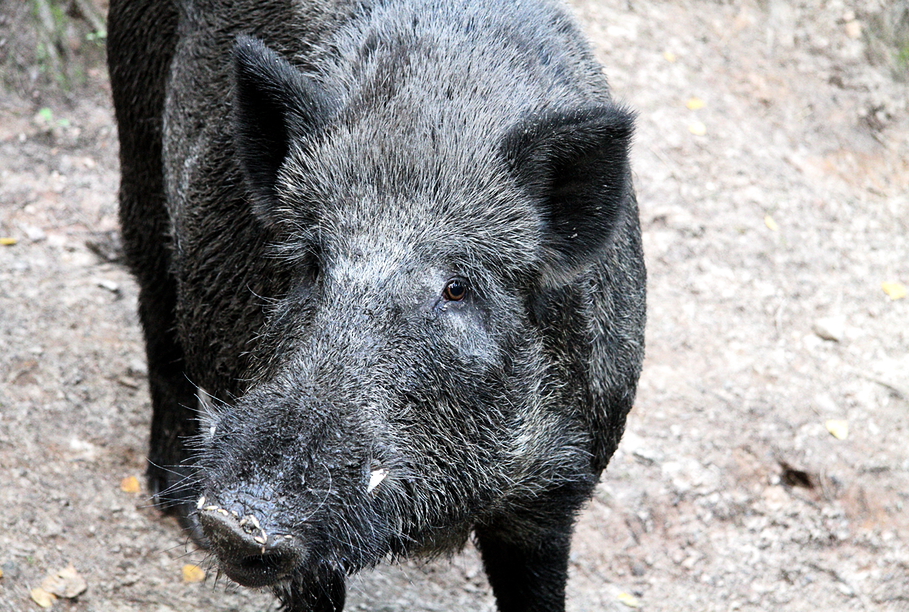Some experts fear the ending of the winter season could bring a new outbreak with the spring.
Egils Rūtiņš is in the forest almost every day, working with his hunting club Ambeļi to try to cull the wild boar herds in the nearby surrounding woodlands. Two of the hunted down specimens in the last three weeks were confirmed to have been infected, likely attributable to the species’ mating time, which falls usually in the month of December.
“The males travel around more and actually leave their territories to visit neighboring herds during the mating season and they mix together,” explained Rūtiņš.
Already in the first two months of this year there have been 43 cases of ASF confirmed in wild boar that were hunted down or found in the area. While affecting so far 17 parishes or counties in eight administrative territorial districts, the most critical situation now seems to be in Vidzeme province.
The state Food and Veterinary Service’s (PVD) Southern Latgale department inspector Gatis Bernāns said that a recent cluster of 13 cases were discovered with wild boar carcasses in a concentrated area in Rencēni county of Burtnieki district. “We’ve never seen such a single fall of a herd before. All generations of the swine were infected,” said the PVD inspector.
Though the fight against ASF has been on in force since last year, Bernāns pointed out it will probably take a long time to stamp out the infection, since very little is known about the disease, which is deadly to pigs only.
“One primary factor is carrier contact. The wild boar interact among herds. But how it gets to domestic pigs still needs to be understood. I personally believe that bugs have an important role to play here, but that needs to be proven,” suggested the state veterinary inspector.
Though the last domestic pig confirmed to have had ASF was noted last September, the PVD has urged all pig farmers to keep up the biosecurity measures even during the winter, when lower temperatures tend to slow down the bacterial growth. Experts have warned that the measures may need to remain in place for three years still, as the new cases among wild boar keep turning up.
The way the fight against ASF in Latgale province is proceeding can seem quite harsh and unpleasant. One mobile incinerator facility in Daugavpils district has been cremating the carcasses found throughout the area. The incinerators are operated about two full days out of each week. Latvian Television’s environmental news crew Vides fakti filmed an exclusive video segment on how the cremations happen.
There’s a special container for the diesel fuel that fires up the incinerator. In one hour the cremation box consumes about 50 liters of diesel.
Local governments facing the ASF crisis have placed special containers for hunters to deposit the carcasses and byproducts for keeping before transport to the Daugavpils crematorium. “Altogether we’ve liquidated more than 300 tons of byproduct into ash,” PVD Infectious Animal Disease Control unit senior inspector Mārtiņš Seržants told Vides fakti.
Pig farmers anywhere in Latvia, not just in the affected provinces, must remain vigilant against the widespread risks of infection. In Dagda district of Latgale, where pig farmers like Anna had to slaughter their herds, or some parts of them, to avoid the prohibitive expense of stringent biosecurity measures. She told Vides fakti she doesn’t fear ASF anymore and thinks the risks were exaggerated.
But PVD inspectors warn local farmers not to become complacent about limiting the outside world’s contact with their vulnerable pig herds. At Dagda district farm Līva, one of the pig-keeping barns was liquidated and the herd reduced by half as a precaution. But outside in the snow near the farm, there are bloodstains the masters of the homestead can only hope did not come from wild boar. Every week a forest worker or hunter finds another victim of the disease somewhere in the woods.
Tellingly, outbreaks near Dagda seem to be found near railroad tracks. “It’s very possible that people taking the train from Russia and Belarus bring infected meat products into Latvia and litter them out the window, where they then can infect the local wild boar,” suggests PVD inspector Seržants.
“Proof that sausage meat can be infected with ASF came last year, when six out of thirty smoked sausage products we tested were found to be contaminated with the virus,” he explained. The forest is not like a closed barn that you can disinfect and quarantine and then forget about the problem when you’ve relayed the foundation and brought in fresh new piglets. As long as the woods hold the wild population, the risk of the virus spreading this way will remain. Many of the meat products were produced in Belarus and confiscated at the border, he pointed out.
The PVD also believes that Belarus is covering up the true scope of the outbreak in the bordering country to Latvia’s southeast. Even if ASF is eliminated inside Latvian territory, the external risk of infection coming in from across the border will remain.
So pig farmers must remain especially cautious. Soon spring will arrive and people will be heading into the woods again to pick berries and mushrooms. If they tramp with the same footwear from the forest back to the farm and into the pig sty without changing shoes or disinfecting themselves, the ASF virus may again cause many of Latvia’s domestic pigs more suffering and death this year.





























